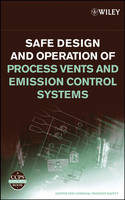Safe Design and Operation of Process Vents and Emission Control Systems
 -15%
portes grátis
-15%
portes grátis
Safe Design and Operation of Process Vents and Emission Control Systems
CCPS (Center for Chemical Process Safety)
John Wiley & Sons Inc
05/2006
344
Dura
Inglês
9780471792963
15 a 20 dias
694
Descrição não disponível.
Preface. Acknowledgment.
1. Introduction.
1.1 Objective.
1.2 Relationship to Other CCPS Publications.
1.3 Industries and Operations Covered.
1.4 Intended Audience.
1.5 How to Use this Book.
1.6 References.
2. Management Overview.
2.1 Impact on Vent Header Systems.
3. Normal Process and Emergency Systems.
3.1 Types of Vent Header Systems.
3.1.1 Normal Process Vent Header Systems.
3.1.2 Emergency Vent Header Systems.
3.1.3 Combined Vent Header Systems.
3.1.4 Considerations.
3.2 Design Philosophy.
3.2.1 Design Sequence.
3.2.2 Hazards Associated with Combining Vent Streams.
3.2.3 Inherent Safety.
3.2.4 Flammability and Combustibility.
3.2.5 Toxicity.
3.2.6 Reactivity.
3.2.7 Regulatory Issues.
3.3 Reference.
4. Combustion and Flammability.
4.1 Flammable Limits.
4.1.1 Mixture Stoichiometry.
4.1.2 Factors Influencing Flammable Limits.
4.1.3 Flammable Limit Variability.
4.1.4 Effects of Temperature on Flammable Limits.
4.1.5 Effects of Pressure on Flammable Limits.
4.1.6 Flammable Limits of Combined Gas Streams.
4.1.7 Cool Flame.
4.1.8 Hybrid Mixtures.
4.2 Limiting Oxidant Concentration.
4.3 Deflagrations.
4.4 Pressure Piling.
4.5 Detonation Phenomena.
4.5.1 Deflagration to Detonation Transition (DDT) and Run-Up Distance.
4.5.2 Overdriven and Stable Detonations.
4.5.3 Detonation Cell Size.
4.6 References.
5. Understanding Requirements.
5.1 Understanding the Sources.
5.1.1 Identify Vent Sources.
5.1.2 Identify Normal Process Vent Streams.
5.1.3 Normal Process Vent System, Design Case Scenario.
5.1.4 Define Interface Requirements.
5.1.5 Identify Hazard Scenarios That Could Result in Emergency Venting.
5.1.6 Vent Gas Characteristics for Emergency Venting.
5.1.7 Emergency Venting Design Case Scenario.
5.1.8 Liquid Entrainment or Condensation in Normal Process Vent Headers.
5.1.9 Two-Phase Venting.
5.1.10 Flammable Gases and Vapors.
5.1.11 Toxic and Noxious Materials.
5.1.12 Reactive Systems.
5.2 Regulatory Issues.
5.2.1 Historical Background.
5.2.2 Brief Review of Laws and Regulations.
5.2.3 Improved Air Quality.
5.3 At-Source Treatment Options.
5.4 Combining Vent Streams.
5.5 End-of-Line Treatment Systems.
5.6 Specify Design Requirements.
5.7 References.
6. Design Approach.
6.1 Design Basis.
6.2 Merging Vent Streams.
6.2.1 Features Favorable for Merging Steams.
6.2.2 Features that do not Favor Merging Streams.
6.3 Vent Header Systems Handling Flammable Materials.
6.3.1 Explosion Prevention.
6.3.2 Operating Fuel Lean.
6.3.3 Operating Inerted.
6.3.4 Operating Fuel Rich.
6.3.5 Oxidizers Other Than Oxygen.
6.3.6 Explosion Protection.
6.3.7 Ignition Sources.
6.4 Vent Header Systems Handling Toxic Gases.
6.4.1 Operating Principles for Header Systems Handling Toxic Gases.
6.4.2 Piping Design.
6.4.3 Combined Relief Valve and Rupture Disk Devices.
6.5 Reactive Systems.
6.5.1 Reactive Systems Design Considerations.
6.6 Mechanical Design Considerations.
6.6.1 Vent Header Pipe Specifications.
6.6.2 Vent Header Supports.
6.6.3 Stresses on Vent Header Piping.
6.6.4 Shock Waves Downstream of Rupture Disks.
6.6.5 Corrosion.
6.6.6 Header Operating Pressure and Pressure Drop.
6.6.7 Thermal Stresses and Low Temperature Embrittlement.
6.6.8 Liquid Knock-Out and Drainage.
6.6.9 Expansion Joints and Flexible Connections.
6.6.10 Valves in the Vent Header System.
6.7 References.
7. Treatment and Disposal Systems.
7.1 Selection of Treatment and Disposal Methods.
7.2 Collection.
7.2.1 Containment.
7.2.2 Collection with Venting.
7.2.3 Dump and Catch Tanks.
7.2.4 Blowdown Drums and Tanks.
7.2.5 Quench Drums.
7.2.6 Quench Pools.
7.2.7 Advantages and Disadvantages ? Collection Systems.
7.3 Physical Separation.
7.3.1 Vapor-Liquid Gravity Separators.
7.3.2 Knock-Out Tanks and Drums.
7.3.3 Mist Eliminators.
7.3.4 Cyclones.
7.3.5 Advantages and Disadvantages ? Physical Separators.
7.4 Absorption.
7.4.1 Spray Towers.
7.4.2 Tray Towers.
7.4.3 Packed-Bed Scrubber.
7.4.4 Venturi Scrubbers.
7.4.5 Advantages and Disadvantages -- Absorption Systems.
7.5 Adsorption 156.
7.5.1 Advantages and Disadvantages -- Carbon Adsorption.
7.6 Recovery.
7.6.1 Condensing Systems.
7.6.2 Gas Recovery Systems.
7.6.3 Advantages and Disadvantages -- Recovery Systems.
7.7 Thermal Destruction.
7.7.1 Flares.
7.7.2 Thermal and Catalytic Oxidizers.
7.7.3 Process Heaters Used for Thermal Destruction.
7.7.4 Advantages and Disadvantages -- Thermal Destruction Systems.
7.8 Dispersion of Vent Gas.
7.8.1 Design and Safety Considerations.
7.8.2 Atmospheric Dispersion Design.
7.8.3 Advantages and Disadvantages -- Dispersion to Atmosphere.
7.9 References.
8. Hazard Analysis and Consequence Assessment.
8.1 Hazard Analysis Methods.
8.2 Hazard Analysis Process.
8.2.1 Identification of Causes.
8.2.2 Development of Consequences.
8.2.3 Estimation of Hazard Scenario Risk.
8.3 Consequence Assessment Techniques.
8.4 References.
9. Operations and Maintenance.
9.1 Daily Inspections.
9.2 Scheduled Inspections and Maintenance.
9.2.1 Materials Build-Up.
9.2.2 Pressure Relief Valves and Rupture Disks.
9.2.3 Conservation Vents.
9.2.4 Explosion Prevention Systems.
9.2.5 Fast Acting Valves and Chemical Isolation Systems.
9.2.6 Explosion Relief Panels.
9.2.7 Inerting Systems.
9.2.8 Instrument and Controls.
9.2.9 Low Point Drains.
9.2.10 Corrosion and Erosion.
9.2.11 Structural Supports for Vent Headers.
9.2.12 Insulation and Heat Tracing.
9.3 Management of Change.
9.4 References.
A. Acronyms and Abbreviations.
B. Glossary.
C. Selected US Environmental Air Pollution Control Regulations.
D. Vent Header Design Checklist.
E. Normal Vent Header Source Control and Configuration Examples.
F. PHA HAZOP Deviation Table.
G. Worked Examples.
G1. Inerted Flammable Liguid Storage.
G2. Flamable Liquid Process Operating Fuel Lean.
G3. Flamable Liquid Process Operating Fuel Rich.
G4. Flamable Liquid Process Operating Fuel Rich.
G5. Refinery Example: Crude and Vacuum Units.
G6. Refinery Example: Coker Unit and Gas Processing Plant.
G7. Reactive System.
H. Past Incidents.
H1. Combustion Incidents.
H2. Reactive Chemical Incidnets.
H3. Vacuum Failures.
H4. References.
I. Historical Perspective on Air Pollution Control.
I1. Historical Background on Air Pollution.
I2. Brief Review of Laws and Regulations.
I3. Improved Air Quality.
I4. References.
1. Introduction.
1.1 Objective.
1.2 Relationship to Other CCPS Publications.
1.3 Industries and Operations Covered.
1.4 Intended Audience.
1.5 How to Use this Book.
1.6 References.
2. Management Overview.
2.1 Impact on Vent Header Systems.
3. Normal Process and Emergency Systems.
3.1 Types of Vent Header Systems.
3.1.1 Normal Process Vent Header Systems.
3.1.2 Emergency Vent Header Systems.
3.1.3 Combined Vent Header Systems.
3.1.4 Considerations.
3.2 Design Philosophy.
3.2.1 Design Sequence.
3.2.2 Hazards Associated with Combining Vent Streams.
3.2.3 Inherent Safety.
3.2.4 Flammability and Combustibility.
3.2.5 Toxicity.
3.2.6 Reactivity.
3.2.7 Regulatory Issues.
3.3 Reference.
4. Combustion and Flammability.
4.1 Flammable Limits.
4.1.1 Mixture Stoichiometry.
4.1.2 Factors Influencing Flammable Limits.
4.1.3 Flammable Limit Variability.
4.1.4 Effects of Temperature on Flammable Limits.
4.1.5 Effects of Pressure on Flammable Limits.
4.1.6 Flammable Limits of Combined Gas Streams.
4.1.7 Cool Flame.
4.1.8 Hybrid Mixtures.
4.2 Limiting Oxidant Concentration.
4.3 Deflagrations.
4.4 Pressure Piling.
4.5 Detonation Phenomena.
4.5.1 Deflagration to Detonation Transition (DDT) and Run-Up Distance.
4.5.2 Overdriven and Stable Detonations.
4.5.3 Detonation Cell Size.
4.6 References.
5. Understanding Requirements.
5.1 Understanding the Sources.
5.1.1 Identify Vent Sources.
5.1.2 Identify Normal Process Vent Streams.
5.1.3 Normal Process Vent System, Design Case Scenario.
5.1.4 Define Interface Requirements.
5.1.5 Identify Hazard Scenarios That Could Result in Emergency Venting.
5.1.6 Vent Gas Characteristics for Emergency Venting.
5.1.7 Emergency Venting Design Case Scenario.
5.1.8 Liquid Entrainment or Condensation in Normal Process Vent Headers.
5.1.9 Two-Phase Venting.
5.1.10 Flammable Gases and Vapors.
5.1.11 Toxic and Noxious Materials.
5.1.12 Reactive Systems.
5.2 Regulatory Issues.
5.2.1 Historical Background.
5.2.2 Brief Review of Laws and Regulations.
5.2.3 Improved Air Quality.
5.3 At-Source Treatment Options.
5.4 Combining Vent Streams.
5.5 End-of-Line Treatment Systems.
5.6 Specify Design Requirements.
5.7 References.
6. Design Approach.
6.1 Design Basis.
6.2 Merging Vent Streams.
6.2.1 Features Favorable for Merging Steams.
6.2.2 Features that do not Favor Merging Streams.
6.3 Vent Header Systems Handling Flammable Materials.
6.3.1 Explosion Prevention.
6.3.2 Operating Fuel Lean.
6.3.3 Operating Inerted.
6.3.4 Operating Fuel Rich.
6.3.5 Oxidizers Other Than Oxygen.
6.3.6 Explosion Protection.
6.3.7 Ignition Sources.
6.4 Vent Header Systems Handling Toxic Gases.
6.4.1 Operating Principles for Header Systems Handling Toxic Gases.
6.4.2 Piping Design.
6.4.3 Combined Relief Valve and Rupture Disk Devices.
6.5 Reactive Systems.
6.5.1 Reactive Systems Design Considerations.
6.6 Mechanical Design Considerations.
6.6.1 Vent Header Pipe Specifications.
6.6.2 Vent Header Supports.
6.6.3 Stresses on Vent Header Piping.
6.6.4 Shock Waves Downstream of Rupture Disks.
6.6.5 Corrosion.
6.6.6 Header Operating Pressure and Pressure Drop.
6.6.7 Thermal Stresses and Low Temperature Embrittlement.
6.6.8 Liquid Knock-Out and Drainage.
6.6.9 Expansion Joints and Flexible Connections.
6.6.10 Valves in the Vent Header System.
6.7 References.
7. Treatment and Disposal Systems.
7.1 Selection of Treatment and Disposal Methods.
7.2 Collection.
7.2.1 Containment.
7.2.2 Collection with Venting.
7.2.3 Dump and Catch Tanks.
7.2.4 Blowdown Drums and Tanks.
7.2.5 Quench Drums.
7.2.6 Quench Pools.
7.2.7 Advantages and Disadvantages ? Collection Systems.
7.3 Physical Separation.
7.3.1 Vapor-Liquid Gravity Separators.
7.3.2 Knock-Out Tanks and Drums.
7.3.3 Mist Eliminators.
7.3.4 Cyclones.
7.3.5 Advantages and Disadvantages ? Physical Separators.
7.4 Absorption.
7.4.1 Spray Towers.
7.4.2 Tray Towers.
7.4.3 Packed-Bed Scrubber.
7.4.4 Venturi Scrubbers.
7.4.5 Advantages and Disadvantages -- Absorption Systems.
7.5 Adsorption 156.
7.5.1 Advantages and Disadvantages -- Carbon Adsorption.
7.6 Recovery.
7.6.1 Condensing Systems.
7.6.2 Gas Recovery Systems.
7.6.3 Advantages and Disadvantages -- Recovery Systems.
7.7 Thermal Destruction.
7.7.1 Flares.
7.7.2 Thermal and Catalytic Oxidizers.
7.7.3 Process Heaters Used for Thermal Destruction.
7.7.4 Advantages and Disadvantages -- Thermal Destruction Systems.
7.8 Dispersion of Vent Gas.
7.8.1 Design and Safety Considerations.
7.8.2 Atmospheric Dispersion Design.
7.8.3 Advantages and Disadvantages -- Dispersion to Atmosphere.
7.9 References.
8. Hazard Analysis and Consequence Assessment.
8.1 Hazard Analysis Methods.
8.2 Hazard Analysis Process.
8.2.1 Identification of Causes.
8.2.2 Development of Consequences.
8.2.3 Estimation of Hazard Scenario Risk.
8.3 Consequence Assessment Techniques.
8.4 References.
9. Operations and Maintenance.
9.1 Daily Inspections.
9.2 Scheduled Inspections and Maintenance.
9.2.1 Materials Build-Up.
9.2.2 Pressure Relief Valves and Rupture Disks.
9.2.3 Conservation Vents.
9.2.4 Explosion Prevention Systems.
9.2.5 Fast Acting Valves and Chemical Isolation Systems.
9.2.6 Explosion Relief Panels.
9.2.7 Inerting Systems.
9.2.8 Instrument and Controls.
9.2.9 Low Point Drains.
9.2.10 Corrosion and Erosion.
9.2.11 Structural Supports for Vent Headers.
9.2.12 Insulation and Heat Tracing.
9.3 Management of Change.
9.4 References.
A. Acronyms and Abbreviations.
B. Glossary.
C. Selected US Environmental Air Pollution Control Regulations.
D. Vent Header Design Checklist.
E. Normal Vent Header Source Control and Configuration Examples.
F. PHA HAZOP Deviation Table.
G. Worked Examples.
G1. Inerted Flammable Liguid Storage.
G2. Flamable Liquid Process Operating Fuel Lean.
G3. Flamable Liquid Process Operating Fuel Rich.
G4. Flamable Liquid Process Operating Fuel Rich.
G5. Refinery Example: Crude and Vacuum Units.
G6. Refinery Example: Coker Unit and Gas Processing Plant.
G7. Reactive System.
H. Past Incidents.
H1. Combustion Incidents.
H2. Reactive Chemical Incidnets.
H3. Vacuum Failures.
H4. References.
I. Historical Perspective on Air Pollution Control.
I1. Historical Background on Air Pollution.
I2. Brief Review of Laws and Regulations.
I3. Improved Air Quality.
I4. References.
Este título pertence ao(s) assunto(s) indicados(s). Para ver outros títulos clique no assunto desejado.
safety; header; venting; collection; manual; design; process; complex; systems; handson; subject; vent; due; requirements; increasingly; treatment; todays; faced; effective; designers; industrial; need; gases; safe; operation
Preface. Acknowledgment.
1. Introduction.
1.1 Objective.
1.2 Relationship to Other CCPS Publications.
1.3 Industries and Operations Covered.
1.4 Intended Audience.
1.5 How to Use this Book.
1.6 References.
2. Management Overview.
2.1 Impact on Vent Header Systems.
3. Normal Process and Emergency Systems.
3.1 Types of Vent Header Systems.
3.1.1 Normal Process Vent Header Systems.
3.1.2 Emergency Vent Header Systems.
3.1.3 Combined Vent Header Systems.
3.1.4 Considerations.
3.2 Design Philosophy.
3.2.1 Design Sequence.
3.2.2 Hazards Associated with Combining Vent Streams.
3.2.3 Inherent Safety.
3.2.4 Flammability and Combustibility.
3.2.5 Toxicity.
3.2.6 Reactivity.
3.2.7 Regulatory Issues.
3.3 Reference.
4. Combustion and Flammability.
4.1 Flammable Limits.
4.1.1 Mixture Stoichiometry.
4.1.2 Factors Influencing Flammable Limits.
4.1.3 Flammable Limit Variability.
4.1.4 Effects of Temperature on Flammable Limits.
4.1.5 Effects of Pressure on Flammable Limits.
4.1.6 Flammable Limits of Combined Gas Streams.
4.1.7 Cool Flame.
4.1.8 Hybrid Mixtures.
4.2 Limiting Oxidant Concentration.
4.3 Deflagrations.
4.4 Pressure Piling.
4.5 Detonation Phenomena.
4.5.1 Deflagration to Detonation Transition (DDT) and Run-Up Distance.
4.5.2 Overdriven and Stable Detonations.
4.5.3 Detonation Cell Size.
4.6 References.
5. Understanding Requirements.
5.1 Understanding the Sources.
5.1.1 Identify Vent Sources.
5.1.2 Identify Normal Process Vent Streams.
5.1.3 Normal Process Vent System, Design Case Scenario.
5.1.4 Define Interface Requirements.
5.1.5 Identify Hazard Scenarios That Could Result in Emergency Venting.
5.1.6 Vent Gas Characteristics for Emergency Venting.
5.1.7 Emergency Venting Design Case Scenario.
5.1.8 Liquid Entrainment or Condensation in Normal Process Vent Headers.
5.1.9 Two-Phase Venting.
5.1.10 Flammable Gases and Vapors.
5.1.11 Toxic and Noxious Materials.
5.1.12 Reactive Systems.
5.2 Regulatory Issues.
5.2.1 Historical Background.
5.2.2 Brief Review of Laws and Regulations.
5.2.3 Improved Air Quality.
5.3 At-Source Treatment Options.
5.4 Combining Vent Streams.
5.5 End-of-Line Treatment Systems.
5.6 Specify Design Requirements.
5.7 References.
6. Design Approach.
6.1 Design Basis.
6.2 Merging Vent Streams.
6.2.1 Features Favorable for Merging Steams.
6.2.2 Features that do not Favor Merging Streams.
6.3 Vent Header Systems Handling Flammable Materials.
6.3.1 Explosion Prevention.
6.3.2 Operating Fuel Lean.
6.3.3 Operating Inerted.
6.3.4 Operating Fuel Rich.
6.3.5 Oxidizers Other Than Oxygen.
6.3.6 Explosion Protection.
6.3.7 Ignition Sources.
6.4 Vent Header Systems Handling Toxic Gases.
6.4.1 Operating Principles for Header Systems Handling Toxic Gases.
6.4.2 Piping Design.
6.4.3 Combined Relief Valve and Rupture Disk Devices.
6.5 Reactive Systems.
6.5.1 Reactive Systems Design Considerations.
6.6 Mechanical Design Considerations.
6.6.1 Vent Header Pipe Specifications.
6.6.2 Vent Header Supports.
6.6.3 Stresses on Vent Header Piping.
6.6.4 Shock Waves Downstream of Rupture Disks.
6.6.5 Corrosion.
6.6.6 Header Operating Pressure and Pressure Drop.
6.6.7 Thermal Stresses and Low Temperature Embrittlement.
6.6.8 Liquid Knock-Out and Drainage.
6.6.9 Expansion Joints and Flexible Connections.
6.6.10 Valves in the Vent Header System.
6.7 References.
7. Treatment and Disposal Systems.
7.1 Selection of Treatment and Disposal Methods.
7.2 Collection.
7.2.1 Containment.
7.2.2 Collection with Venting.
7.2.3 Dump and Catch Tanks.
7.2.4 Blowdown Drums and Tanks.
7.2.5 Quench Drums.
7.2.6 Quench Pools.
7.2.7 Advantages and Disadvantages ? Collection Systems.
7.3 Physical Separation.
7.3.1 Vapor-Liquid Gravity Separators.
7.3.2 Knock-Out Tanks and Drums.
7.3.3 Mist Eliminators.
7.3.4 Cyclones.
7.3.5 Advantages and Disadvantages ? Physical Separators.
7.4 Absorption.
7.4.1 Spray Towers.
7.4.2 Tray Towers.
7.4.3 Packed-Bed Scrubber.
7.4.4 Venturi Scrubbers.
7.4.5 Advantages and Disadvantages -- Absorption Systems.
7.5 Adsorption 156.
7.5.1 Advantages and Disadvantages -- Carbon Adsorption.
7.6 Recovery.
7.6.1 Condensing Systems.
7.6.2 Gas Recovery Systems.
7.6.3 Advantages and Disadvantages -- Recovery Systems.
7.7 Thermal Destruction.
7.7.1 Flares.
7.7.2 Thermal and Catalytic Oxidizers.
7.7.3 Process Heaters Used for Thermal Destruction.
7.7.4 Advantages and Disadvantages -- Thermal Destruction Systems.
7.8 Dispersion of Vent Gas.
7.8.1 Design and Safety Considerations.
7.8.2 Atmospheric Dispersion Design.
7.8.3 Advantages and Disadvantages -- Dispersion to Atmosphere.
7.9 References.
8. Hazard Analysis and Consequence Assessment.
8.1 Hazard Analysis Methods.
8.2 Hazard Analysis Process.
8.2.1 Identification of Causes.
8.2.2 Development of Consequences.
8.2.3 Estimation of Hazard Scenario Risk.
8.3 Consequence Assessment Techniques.
8.4 References.
9. Operations and Maintenance.
9.1 Daily Inspections.
9.2 Scheduled Inspections and Maintenance.
9.2.1 Materials Build-Up.
9.2.2 Pressure Relief Valves and Rupture Disks.
9.2.3 Conservation Vents.
9.2.4 Explosion Prevention Systems.
9.2.5 Fast Acting Valves and Chemical Isolation Systems.
9.2.6 Explosion Relief Panels.
9.2.7 Inerting Systems.
9.2.8 Instrument and Controls.
9.2.9 Low Point Drains.
9.2.10 Corrosion and Erosion.
9.2.11 Structural Supports for Vent Headers.
9.2.12 Insulation and Heat Tracing.
9.3 Management of Change.
9.4 References.
A. Acronyms and Abbreviations.
B. Glossary.
C. Selected US Environmental Air Pollution Control Regulations.
D. Vent Header Design Checklist.
E. Normal Vent Header Source Control and Configuration Examples.
F. PHA HAZOP Deviation Table.
G. Worked Examples.
G1. Inerted Flammable Liguid Storage.
G2. Flamable Liquid Process Operating Fuel Lean.
G3. Flamable Liquid Process Operating Fuel Rich.
G4. Flamable Liquid Process Operating Fuel Rich.
G5. Refinery Example: Crude and Vacuum Units.
G6. Refinery Example: Coker Unit and Gas Processing Plant.
G7. Reactive System.
H. Past Incidents.
H1. Combustion Incidents.
H2. Reactive Chemical Incidnets.
H3. Vacuum Failures.
H4. References.
I. Historical Perspective on Air Pollution Control.
I1. Historical Background on Air Pollution.
I2. Brief Review of Laws and Regulations.
I3. Improved Air Quality.
I4. References.
1. Introduction.
1.1 Objective.
1.2 Relationship to Other CCPS Publications.
1.3 Industries and Operations Covered.
1.4 Intended Audience.
1.5 How to Use this Book.
1.6 References.
2. Management Overview.
2.1 Impact on Vent Header Systems.
3. Normal Process and Emergency Systems.
3.1 Types of Vent Header Systems.
3.1.1 Normal Process Vent Header Systems.
3.1.2 Emergency Vent Header Systems.
3.1.3 Combined Vent Header Systems.
3.1.4 Considerations.
3.2 Design Philosophy.
3.2.1 Design Sequence.
3.2.2 Hazards Associated with Combining Vent Streams.
3.2.3 Inherent Safety.
3.2.4 Flammability and Combustibility.
3.2.5 Toxicity.
3.2.6 Reactivity.
3.2.7 Regulatory Issues.
3.3 Reference.
4. Combustion and Flammability.
4.1 Flammable Limits.
4.1.1 Mixture Stoichiometry.
4.1.2 Factors Influencing Flammable Limits.
4.1.3 Flammable Limit Variability.
4.1.4 Effects of Temperature on Flammable Limits.
4.1.5 Effects of Pressure on Flammable Limits.
4.1.6 Flammable Limits of Combined Gas Streams.
4.1.7 Cool Flame.
4.1.8 Hybrid Mixtures.
4.2 Limiting Oxidant Concentration.
4.3 Deflagrations.
4.4 Pressure Piling.
4.5 Detonation Phenomena.
4.5.1 Deflagration to Detonation Transition (DDT) and Run-Up Distance.
4.5.2 Overdriven and Stable Detonations.
4.5.3 Detonation Cell Size.
4.6 References.
5. Understanding Requirements.
5.1 Understanding the Sources.
5.1.1 Identify Vent Sources.
5.1.2 Identify Normal Process Vent Streams.
5.1.3 Normal Process Vent System, Design Case Scenario.
5.1.4 Define Interface Requirements.
5.1.5 Identify Hazard Scenarios That Could Result in Emergency Venting.
5.1.6 Vent Gas Characteristics for Emergency Venting.
5.1.7 Emergency Venting Design Case Scenario.
5.1.8 Liquid Entrainment or Condensation in Normal Process Vent Headers.
5.1.9 Two-Phase Venting.
5.1.10 Flammable Gases and Vapors.
5.1.11 Toxic and Noxious Materials.
5.1.12 Reactive Systems.
5.2 Regulatory Issues.
5.2.1 Historical Background.
5.2.2 Brief Review of Laws and Regulations.
5.2.3 Improved Air Quality.
5.3 At-Source Treatment Options.
5.4 Combining Vent Streams.
5.5 End-of-Line Treatment Systems.
5.6 Specify Design Requirements.
5.7 References.
6. Design Approach.
6.1 Design Basis.
6.2 Merging Vent Streams.
6.2.1 Features Favorable for Merging Steams.
6.2.2 Features that do not Favor Merging Streams.
6.3 Vent Header Systems Handling Flammable Materials.
6.3.1 Explosion Prevention.
6.3.2 Operating Fuel Lean.
6.3.3 Operating Inerted.
6.3.4 Operating Fuel Rich.
6.3.5 Oxidizers Other Than Oxygen.
6.3.6 Explosion Protection.
6.3.7 Ignition Sources.
6.4 Vent Header Systems Handling Toxic Gases.
6.4.1 Operating Principles for Header Systems Handling Toxic Gases.
6.4.2 Piping Design.
6.4.3 Combined Relief Valve and Rupture Disk Devices.
6.5 Reactive Systems.
6.5.1 Reactive Systems Design Considerations.
6.6 Mechanical Design Considerations.
6.6.1 Vent Header Pipe Specifications.
6.6.2 Vent Header Supports.
6.6.3 Stresses on Vent Header Piping.
6.6.4 Shock Waves Downstream of Rupture Disks.
6.6.5 Corrosion.
6.6.6 Header Operating Pressure and Pressure Drop.
6.6.7 Thermal Stresses and Low Temperature Embrittlement.
6.6.8 Liquid Knock-Out and Drainage.
6.6.9 Expansion Joints and Flexible Connections.
6.6.10 Valves in the Vent Header System.
6.7 References.
7. Treatment and Disposal Systems.
7.1 Selection of Treatment and Disposal Methods.
7.2 Collection.
7.2.1 Containment.
7.2.2 Collection with Venting.
7.2.3 Dump and Catch Tanks.
7.2.4 Blowdown Drums and Tanks.
7.2.5 Quench Drums.
7.2.6 Quench Pools.
7.2.7 Advantages and Disadvantages ? Collection Systems.
7.3 Physical Separation.
7.3.1 Vapor-Liquid Gravity Separators.
7.3.2 Knock-Out Tanks and Drums.
7.3.3 Mist Eliminators.
7.3.4 Cyclones.
7.3.5 Advantages and Disadvantages ? Physical Separators.
7.4 Absorption.
7.4.1 Spray Towers.
7.4.2 Tray Towers.
7.4.3 Packed-Bed Scrubber.
7.4.4 Venturi Scrubbers.
7.4.5 Advantages and Disadvantages -- Absorption Systems.
7.5 Adsorption 156.
7.5.1 Advantages and Disadvantages -- Carbon Adsorption.
7.6 Recovery.
7.6.1 Condensing Systems.
7.6.2 Gas Recovery Systems.
7.6.3 Advantages and Disadvantages -- Recovery Systems.
7.7 Thermal Destruction.
7.7.1 Flares.
7.7.2 Thermal and Catalytic Oxidizers.
7.7.3 Process Heaters Used for Thermal Destruction.
7.7.4 Advantages and Disadvantages -- Thermal Destruction Systems.
7.8 Dispersion of Vent Gas.
7.8.1 Design and Safety Considerations.
7.8.2 Atmospheric Dispersion Design.
7.8.3 Advantages and Disadvantages -- Dispersion to Atmosphere.
7.9 References.
8. Hazard Analysis and Consequence Assessment.
8.1 Hazard Analysis Methods.
8.2 Hazard Analysis Process.
8.2.1 Identification of Causes.
8.2.2 Development of Consequences.
8.2.3 Estimation of Hazard Scenario Risk.
8.3 Consequence Assessment Techniques.
8.4 References.
9. Operations and Maintenance.
9.1 Daily Inspections.
9.2 Scheduled Inspections and Maintenance.
9.2.1 Materials Build-Up.
9.2.2 Pressure Relief Valves and Rupture Disks.
9.2.3 Conservation Vents.
9.2.4 Explosion Prevention Systems.
9.2.5 Fast Acting Valves and Chemical Isolation Systems.
9.2.6 Explosion Relief Panels.
9.2.7 Inerting Systems.
9.2.8 Instrument and Controls.
9.2.9 Low Point Drains.
9.2.10 Corrosion and Erosion.
9.2.11 Structural Supports for Vent Headers.
9.2.12 Insulation and Heat Tracing.
9.3 Management of Change.
9.4 References.
A. Acronyms and Abbreviations.
B. Glossary.
C. Selected US Environmental Air Pollution Control Regulations.
D. Vent Header Design Checklist.
E. Normal Vent Header Source Control and Configuration Examples.
F. PHA HAZOP Deviation Table.
G. Worked Examples.
G1. Inerted Flammable Liguid Storage.
G2. Flamable Liquid Process Operating Fuel Lean.
G3. Flamable Liquid Process Operating Fuel Rich.
G4. Flamable Liquid Process Operating Fuel Rich.
G5. Refinery Example: Crude and Vacuum Units.
G6. Refinery Example: Coker Unit and Gas Processing Plant.
G7. Reactive System.
H. Past Incidents.
H1. Combustion Incidents.
H2. Reactive Chemical Incidnets.
H3. Vacuum Failures.
H4. References.
I. Historical Perspective on Air Pollution Control.
I1. Historical Background on Air Pollution.
I2. Brief Review of Laws and Regulations.
I3. Improved Air Quality.
I4. References.
Este título pertence ao(s) assunto(s) indicados(s). Para ver outros títulos clique no assunto desejado.





